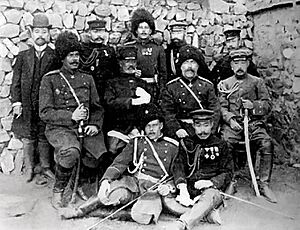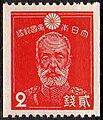Nogi Maresuke facts for kids
Quick facts for kids
Count
Nogi Maresuke
Senior Second Rank
|
|
|---|---|
|
乃木 希典
|
|

Nogi standing before his house in Nogizaka, Tokyo, shortly before his death in 1912
|
|
| Governor General of Taiwan | |
| In office 14 October 1896 – 26 February 1898 |
|
| Monarch | Meiji |
| Preceded by | Katsura Tarō |
| Succeeded by | Kodama Gentarō |
| Personal details | |
| Born | December 25, 1849 Edo, Japan |
| Died | September 13, 1912 (aged 62) Tokyo, Japan |
| Awards |
|
| Nicknames | Kiten Count Nogi |
| Military service | |
| Allegiance | |
| Branch/service | |
| Years of service | 1871–1908 |
| Rank | |
| Battles/wars |
|
Count Nogi Maresuke (born December 25, 1849 – died September 13, 1912) was an important Japanese general in the Imperial Japanese Army. He also served as a governor-general of Taiwan. Nogi was a key commander during the First Sino-Japanese War and the Russo-Japanese War. He was seen as a national hero in Japan. People admired him for his loyalty and willingness to sacrifice for his country.
Contents
Early Life and Family
Nogi Maresuke was born on December 25, 1849, in Edo (which is now Tokyo). He was the third son of Nogi Maretsugu, a samurai cavalry officer. His family served the Chōfu Domain, a smaller area connected to the Chōshū Domain.
His childhood name was Nakito, meaning "no one." This was a way to protect him from evil spirits. Later, he was renamed Maresuke. He married Shizuko when he was 28 years old. They had two sons, Katsunori and Yasunori.
Early Military Career
Nogi began his military training in 1869. He learned the French style of warfare. In 1871, he became a major in the new Imperial Japanese Army. He changed his name to Maresuke around this time.
He fought in the Satsuma Rebellion in 1877. This was a conflict against forces led by Saigō Takamori. For his service, he was promoted to lieutenant colonel. Nogi continued to rise through the ranks. In 1885, he became a major general. He then traveled to Germany to study military strategies.
First Sino-Japanese War
In 1894, Nogi commanded the First Infantry Brigade during the First Sino-Japanese War. His troops successfully captured Port Arthur from China in just one day. After this victory, he was promoted to lieutenant general. He was then assigned to the invasion of Taiwan. Nogi stayed in Taiwan with the occupation forces until 1898.
Governor-General of Taiwan
After the war, Nogi was given the title of danshaku (baron). He was appointed as the third Japanese Governor-General of Taiwan. He held this position from October 1896 to February 1898.
Nogi brought his whole family to Taiwan. Sadly, his mother got malaria and passed away there. This sad event made Nogi work hard to improve healthcare on the island. He wanted to make sure others wouldn't suffer.
Russo-Japanese War
In 1904, Nogi was called back to duty for the Russo-Japanese War. He was promoted to general and put in charge of the Japanese Third Army. His main mission was to capture Port Arthur from the Russians.
Nogi's army faced very strong resistance. The battle for Port Arthur became a long siege. It lasted from August 1904 to January 1905. The Japanese suffered many losses during this time. Despite the difficulties, Emperor Meiji supported Nogi and kept him in command.
After Port Arthur fell, Nogi became a national hero. He then led his Third Army in the final Battle of Mukden. This battle ended the land fighting of the war.
Both of Nogi's sons, Katsunori and Yasunori, were army lieutenants. They were both killed in action during the war. After the war, Nogi reported to Emperor Meiji. He cried while explaining the battles of Port Arthur. He apologized for the 56,000 lives lost.
Postwar Life and Legacy
After the war, Nogi was given the title of count. He also received many important awards. From 1908 to 1912, he was the head of the Peers' School. Here, he became a mentor to the young Hirohito, who would later become the emperor of Japan. Nogi had a very important influence on Hirohito's life.
Nogi used much of his own money to help wounded soldiers. He also built monuments across the country. These monuments honored those who died in the Russo-Japanese War. He even asked the Japanese government to build a memorial for the Russian soldiers who died at Port Arthur.
Scouting Connection
Nogi also played a role in the history of Scouting in Japan. In 1911, he visited England for the coronation of King George V. There, he met General Robert Baden-Powell, who founded the Scouting movement. They were introduced by Lord Kitchener.
Man of Letters
Nogi was also known for his writing. His Kanshi poems, which are poems written in the Chinese language, were very popular in Japan during his time.
Images for kids
-
The Ziziphus jujuba which written in Monbusho chant lyrics, located in Nogi's mansion
-
An Imperial Japanese stamp from 1938 depicting Nogi






